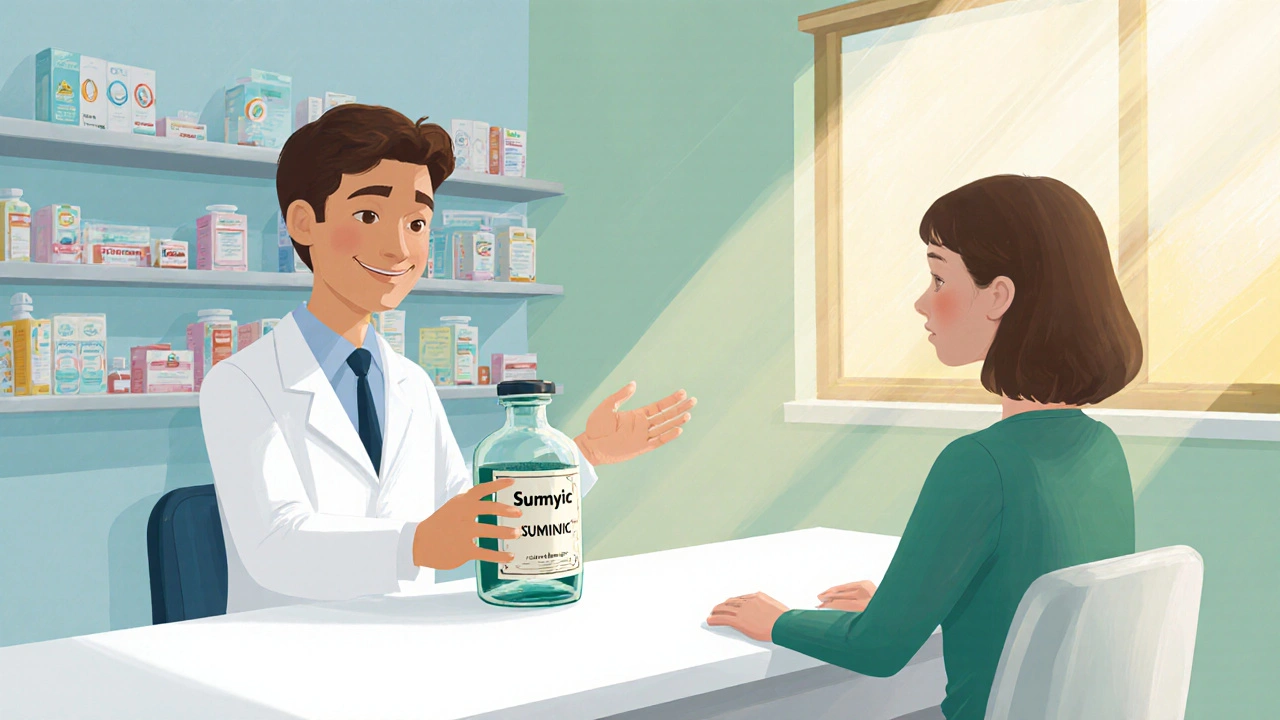Antibiotic Choice Guide
Find Your Best Antibiotic
Select your situation to see which antibiotics are most appropriate for your condition and health profile.
Recommended Antibiotics
Based on your selectionWhen you pick an antibiotic, you want something that clears the infection fast, fits your health profile, and doesn’t break the bank. Sumycin has been a go‑to tetracycline for decades, but newer drugs and even older agents can sometimes do the job better or with fewer side effects. This guide breaks down Sumycin’s strengths, its drawbacks, and how it stacks up against the most popular alternatives on the market today.
Key Takeaways
- Sumycin (tetracycline) is broad‑spectrum but causes more GI upset and photosensitivity than newer tetracyclines.
- Doxycycline and minocycline offer once‑daily dosing and lower food interactions.
- For infections where tetracyclines are contraindicated, macrolides (azithromycin) or fluoroquinolones (ciprofloxacin) are common substitutes.
- Cost varies widely: generic tetracycline is cheap, while newer agents may be pricier but often covered by insurance.
- Always match the drug to the specific infection, patient age, pregnancy status, and renal function.
Understanding Sumycin
Sumycin is a brand name for tetracycline hydrochloride, a broad‑spectrum antibiotic that interferes with bacterial protein synthesis by binding to the 30S ribosomal subunit. Approved by the FDA in the 1960s, it is commonly prescribed for acne, respiratory tract infections, and certain tick‑borne diseases. The standard adult dose is 250 mg to 500 mg taken four times daily on an empty stomach, because food - especially dairy - can cut absorption by up to 50 percent.
How Tetracycline Works
Tetracycline blocks the attachment of amino‑acyl tRNA to the ribosome, halting bacterial growth without directly killing the organism. This bacteriostatic action makes it most effective when the immune system can finish the job. Because it targets a bacterial mechanism absent in human cells, side effects are generally limited to the gut and skin, but the drug can still affect mitochondria at high doses.
Common Alternatives Overview
Below are the top alternatives clinicians consider when Sumycin isn’t the best fit. Each entry includes a concise definition and key attributes.
- Doxycycline is a semi‑synthetic tetracycline derivative that offers once‑daily dosing and better absorption with food.
- Minocycline is another tetracycline analogue noted for its high tissue penetration and lower incidence of GI upset.
- Azithromycin is a macrolide antibiotic that concentrates in tissues and can be given for three days straight for many infections.
- Ciprofloxacin is a fluoroquinolone with excellent activity against Gram‑negative organisms and a convenient twice‑daily schedule.
- Levofloxacin is a newer fluoroquinolone that offers broader Gram‑positive coverage compared to ciprofloxacin.
- Amoxicillin is a beta‑lactam penicillin often used for streptococcal infections and ear infections but lacks activity against atypicals.
- Clindamycin is a lincosamide useful for anaerobic infections and skin‑structure infections when patients can’t take tetracyclines.
- Chloramphenicol is a broad‑spectrum agent reserved for severe infections due to its rare but serious bone‑marrow toxicity.
Side‑Effect Profiles at a Glance
Understanding side‑effects helps you weigh risks. Tetracyclines (including Sumycin) are notorious for:
- Photosensitivity - sun exposure can cause severe burns.
- Gastrointestinal irritation - nausea, vomiting, and esophagitis.
- Dental staining - permanent yellow‑brown discoloration in children under 8.
Newer tetracyclines (doxy‑ and minocycline) reduce GI upset and remove the requirement for a fasted state, though they still cause photosensitivity. Macrolides like azithromycin bring a lower risk of photosensitivity but can cause QT‑interval prolongation. Fluoroquinolones add tendon‑rupture warnings, especially in older adults.
Comparison Table
| Drug | Class | Typical Adult Dose | Common Indications | Major Side Effects | Notable Contra‑indications | Approx. Monthly Cost (USD) |
|---|---|---|---|---|---|---|
| Sumycin (Tetracycline) | Tetracycline | 250‑500 mg PO Q6H (fasted) | Acne, Lyme disease, TB (adjunct) | Photosensitivity, GI upset, tooth discoloration | Pregnancy, children <8 yr, severe liver disease | $12‑$18 |
| Doxycycline | Semi‑synthetic tetracycline | 100 mg PO BID (with food OK) | Chlamydia, Rocky Mountain spotted fever, acne | Photosensitivity, mild GI upset | Pregnancy (use with caution), severe renal impairment | $25‑$35 |
| Minocycline | Semi‑synthetic tetracycline | 100 mg PO BID | Severe acne, rheumatoid arthritis adjunct | Vertigo, autoimmune hepatitis, skin pigmentation | Liver disease, pregnancy | $30‑$45 |
| Azithromycin | Macrolide | 500 mg PO daily ×3 days | Community‑acquired pneumonia, STI, sinusitis | Diarrhea, QT prolongation | History of ventricular arrhythmia, severe liver disease | $45‑$70 |
| Ciprofloxacin | Fluoroquinolone | 500 mg PO BID | UTI, gastroenteritis, bone infections | Tendon rupture, CNS effects | Pregnancy, children, history of tendon disorders | $20‑$40 |
| Levofloxacin | Fluoroquinolone | 750 mg PO daily | Sinusitis, pneumonia, prostatitis | QT prolongation, photosensitivity | Seizure disorders, severe renal impairment | $30‑$55 |
| Amoxicillin | Penicillin (beta‑lactam) | 500 mg PO TID | Strep throat, otitis media, sinusitis | Allergic rash, GI upset | Penicillin allergy, renal failure | $10‑$15 |
| Clindamycin | Lincosamide | 300 mg PO Q6H | Skin and soft‑tissue infections, anaerobic infections | C. difficile colitis, taste change | History of C. difficile infection | $25‑$40 |
| Chloramphenicol | Amphenicol | 500 mg PO Q6H | Severe meningitis, typhoid (rare) | Bone‑marrow suppression, aplastic anemia | Pregnancy, known hematologic disorders | $80‑$120 |
Choosing the Right Option for Your Situation
Instead of memorizing every drug, focus on three decision pillars:
- Infection type: Tetracyclines cover atypicals, rickettsiae, and some gram‑positives. If the pathogen is a typical streptococcus, penicillins like amoxicillin are cheaper and equally effective.
- Patient factors: Age, pregnancy status, liver/kidney function, and existing heart rhythm disorders can rule out certain classes. For example, avoid Sumycin in a pregnant teenager; choose azithromycin or amoxicillin instead.
- Side‑effect tolerance: If the patient works outdoors, photosensitivity from tetracyclines may be a deal‑breaker. In that case, a macrolide or fluoroquinolone with less sun sensitivity could be safer.
After you line up the infection, patient, and side‑effect criteria, the table above quickly shows which drug fits best.

Safety and Interaction Considerations
All antibiotics carry interaction risks. Here are the most common pairings to watch:
- Calcium‑rich foods or antacids - dramatically cut tetracycline absorption; take Sumycin at least 2 hours before or after dairy.
- Warfarin - fluoroquinolones can enhance anticoagulant effect, raising bleeding risk.
- Statins - certain macrolides (e.g., erythromycin) raise statin levels; azithromycin is safer but still requires monitoring.
- Oral contraceptives - tetracyclines may reduce efficacy; recommend backup contraception.
Always run a medication reconciliation before prescribing, especially for patients on chronic therapies.
Cost and Accessibility in 2025
Insurance formularies still favor generic tetracycline for uncomplicated cases because it’s cheap. However, many insurers place doxycycline and minocycline on a higher tier due to brand preference, which can increase out‑of‑pocket costs. Fluoroquinolones often require prior authorization because of safety warnings, delaying treatment.
If cost is a primary concern, Sumycin remains the most affordable broad‑spectrum option, but you’ll need to manage the dosing schedule and food restrictions. For patients who can’t tolerate the fasting requirement, switching to doxycycline (still generic in most states) offers a balance of cost and convenience.
FAQs
Is Sumycin still prescribed for acne in 2025?
Yes, but most dermatologists now prefer doxycycline or minocycline because they require fewer doses and have a lower risk of GI upset. Sumycin is usually reserved for patients who cannot afford the newer agents.
Can I take Sumycin with calcium supplements?
No. Calcium binds to tetracycline and cuts absorption by up to 50 %. Take Sumycin at least two hours before or after any calcium‑rich food or supplement.
What makes doxycycline more convenient than Sumycin?
Doxycycline can be taken with meals, has a longer half‑life allowing twice‑daily dosing, and carries a lower risk of photosensitivity. This makes it easier for patients with busy schedules.
Are fluoroquinolones safe for children?
Generally no. The FDA warns against use in patients under 18 because of risks to developing cartilage and joints. Reserve them for severe infections where no safer alternative exists.
How do I know if I’m allergic to tetracyclines?
Allergic reactions typically appear as rash, itching, or swelling within minutes to hours after the first dose. If you suspect an allergy, stop the medication and seek medical advice immediately.
Bottom line: Sumycin remains a solid, low‑cost option for many bacterial infections, but newer tetracyclines, macrolides, and fluoroquinolones often provide better tolerability and simpler dosing. Match the drug to the infection, the patient’s health profile, and the cost landscape, and you’ll end up with the most effective, safest choice.


Thanks for the detailed breakdown! Sumycin’s broad‑spectrum coverage can be handy, but the four‑times‑daily schedule and food restrictions really limit its convenience. If a patient can tolerate doxycycline, the once‑daily dosing and better GI tolerance often make it a smoother choice. Also, keep an eye on photosensitivity during summer months – sunscreen is a must.
Whoa, reading this feels like a drug‑battle royale! 🎉 Sumycin may be the old‑school heavyweight, but Doxy and Minocycline are the sleek, modern ninjas slipping past food‑interaction traps. And let’s not forget azithromycin’s three‑day sprint – it’s practically the sprinter of the antibiotic world! 🌟
One must question the very premise of glorifying a 1960s tetracycline when contemporary pharmacology offers far superior pharmacokinetic profiles. The plebeian reliance on Sumycin betrays a lamentable adherence to antiquated dogma, rendering the discussion an exercise in nostalgic futility.
Ah, the timeless charm of Sumycin – nothing says “I care about your wallet” like a regimen that demands emptiness of the stomach and relentless sun avoidance. 😏 If only efficacy could be measured in inconvenience, perhaps this classic would finally rise to its deserved pedestal.
Sumycin works well for many infections, but the dosing schedule can be a hassle for patients with busy lives. Newer tetracyclines like doxycycline simplify therapy, and they’re generally easier on the stomach.
Sure, Sumycin is cheap, but who wants a four‑dose‑a‑day headache? 🤷♂️
It is incumbent upon the prescriber to weigh the pharmacodynamic merits of Sumycin against its pharmacokinetic liabilities, particularly the pronounced reduction in bioavailability consequent upon concomitant dairy consumption.